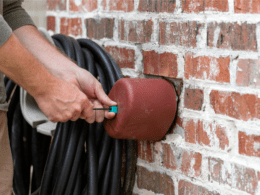Are you looking to add some excitement to your backyard? Hanging a tree swing can provide hours of fun for kids and adults alike. However, safety should always be a top priority when it comes to outdoor activities.
In this article, you’ll learn how to safely and securely hang a tree swing, ensuring that everyone who uses it can swing into fun without any accidents or injuries.
First, we’ll explore different methods for hanging a tree swing. From traditional rope and chain to specialized hanging kits, there are a variety of options to choose from. We’ll discuss the pros and cons of each method, as well as how to properly install them to ensure maximum safety.
Then, we’ll provide some safety tips to keep in mind while using the swing, such as the importance of inspecting the swing and hanging materials regularly and setting rules for safe usage.
With this information, you’ll be able to create a backyard oasis that provides endless hours of fun for everyone while keeping safety at the forefront.
Quick Takeaways
- Safety is a top priority when it comes to hanging a tree swing.
- Different methods for hanging a tree swing are available, including traditional rope and chain, specialized hanging kits, artificial branch method, and crossbeam method.
- Hardware rated to hold a minimum of 1000 pounds should always be used, and regular inspection of the swing and hardware is important to ensure they’re in good condition.
- Trees such as oak, maple, sycamore, or beech with recommended spacing and diameter should be chosen for stability and safety.
Methods for Hanging
If you don’t have any branches to hang your swing on, don’t worry! You can use the artificial branch method or the crossbeam method for hanging your swing between two trees.
The artificial branch method involves attaching a sturdy, artificial branch to the tree using lag bolts or eye-bolts. This is a great option for trees without branches or for those who want a more permanent swing installation.
The crossbeam method involves hanging the swing between two trees using a sturdy crossbeam. This method is great for those who want a more traditional swing installation.
Another option for hanging a swing on angled branches is to use PVC pipe and eye-bolts. This method is great for those who want to hang a swing on branches that grow on an angle.
Regardless of the method you choose, always remember to use hardware rated to hold a minimum of 1000 pounds and to regularly inspect the artificial branch and swing hardware for safety.
Can I Grow Fruit Vines to Hang a Tree Swing From?
Yes, you can maximize space with fruit vines and create a unique hangout spot. By carefully selecting and training appropriate fruit vines, such as grapes or kiwis, you can create a sturdy and natural structure to hang a tree swing from. Just ensure that the vines have sufficient support to grow and spread, providing a safe and enjoyable swinging experience.
Safety Tips
Always have a partner when constructing and inspecting the artificial branch or hardware for your swing, and make sure to choose trees with recommended spacing and diameter to ensure stability and safety.
Regular inspection of the artificial branch and swing hardware is important to ensure they’re in good condition. Check for any signs of wear and tear, such as rust, cracks, or fraying ropes. Replace any damaged parts immediately with recommended materials to ensure the swing remains safe.
When attaching the swing to a crossbeam or angled branch, it’s important to use eye-bolts, straps, or other hardware rated to hold a minimum of 1000 pounds. Keep the swing at least three feet away from the tree trunk for safety. For added protection, strap with hooks around the entire plank is recommended for 2×10 plank swings to prevent splitting.
Inspection frequency may vary, but it’s recommended to inspect the swing and hardware at least once a month to ensure everything is in good condition. By following these safety tips, you can enjoy your swing with peace of mind knowing that it’s secure and safe.
Additional Information
To ensure the stability of your swing, choose trees such as oak, maple, sycamore, or beech with recommended spacing and diameter. Consider laminating two planks together for older kids to play hard on. These types of trees have strong branches that can handle the weight of a swing, and the recommended spacing and diameter will provide the necessary stability and safety.
Laminating two planks together will make the swing stronger and more durable, which is especially important if older kids will be using it frequently. Swing maintenance is also important for ensuring safety. The swing rope should be replaced every two years with marine-grade UV-protected rope or braided polypropylene synthetic rope.
Additionally, dual-rope swings should have upper attachments four inches wider than the width of the swing. A strap with hooks around the entire plank is recommended for 2×10 plank swings to prevent splitting. By following these guidelines for tree selection and swing maintenance, you can ensure that your swing is safe and enjoyable for years to come.
Frequently Asked Questions
What is the maximum weight capacity for a swing hung from a tree using the recommended hardware and methods?
Your swing’s maximum weight capacity depends on the hardware and method used to hang it. With proper eye-bolts, straps, or other hardware rated to hold 1000 pounds and correct suspension height, swings can safely support children and adults.
Can a swing be hung from a tree with a diameter less than 12 inches?
For safety and stability, it is recommended to hang a swing from a tree with a diameter of at least 12 inches. If you must use a smaller tree, alternative hanging methods and tree species compatibility should be considered.
Are there any regulations or permits required for hanging a swing from a tree in a public space, such as a park?
To hang a swing from a tree in a public space, like a park, you may need to obtain permit requirements. You must also follow safety guidelines, such as using appropriate hardware and regularly inspecting the swing and tree.
How do you prevent the swing from rubbing against the tree trunk and causing damage?
To prevent swing damage and maintain your tree, ensure the swing is at least three feet away from the trunk. Regularly inspect the hardware and replace the rope every two years with UV-protected rope. Choose a suitable tree and use proper hardware.
What should you do if you notice any signs of wear or damage to the swing or hardware during regular inspections?
Regular maintenance is key to ensuring that your swing is safe for use. If you notice any signs of wear or damage to the swing or hardware during regular inspections, replace them immediately. Having a replacement plan in place will ensure continued safety for your family.








